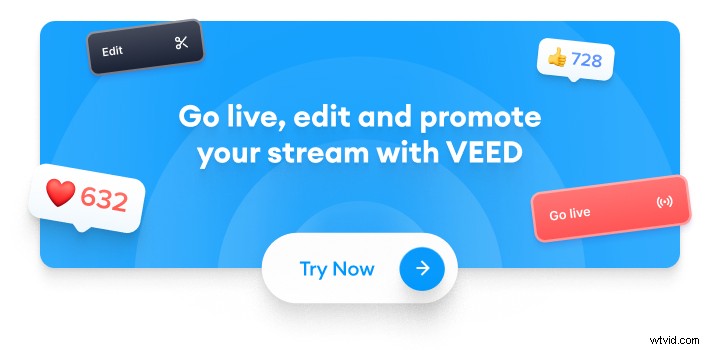La transmisión de video en vivo es una forma increíble de conectarse con su audiencia. El estrés de la perfección como creador es menor que en los videos editados. Lo que es aún mejor:puedes interactuar con tus seguidores siendo tú mismo.
Y con la creciente popularidad de la transmisión, transmitir en vivo también es bueno para los negocios. Según un informe de Hootsuite, las marcas obtienen siete veces más reacciones y 24 veces más comentarios en las transmisiones de LinkedIn Live que en los videos normales.
Sin embargo, muchos creadores, vendedores o dueños de negocios no saben cómo transmitir en vivo. Aprender software complejo y elegir la plataforma y el equipo de transmisión correctos les da vueltas la cabeza.
¿Eres uno de ellos?
No te preocupes. Como siempre, estamos aquí para ayudar
Este blog lo guiará a través de todo lo que necesita saber sobre la transmisión en vivo desde cero. Hablaremos de:
- ¿Qué es la transmisión en vivo?
- ¿Cuál es la mejor plataforma de transmisión en vivo?
- Equipo:¿Qué necesitas para comenzar a transmitir?
- Ideas de contenido de transmisión en vivo
- ¿Cómo transmitir en vivo a múltiples plataformas con VEED?
- 6 mejores prácticas de transmisión en vivo

[#TOC1]¿Qué es la transmisión en vivo?[#TOC1]
La transmisión en vivo es el proceso de transmisión de contenido de video en tiempo real a través de Internet.
La transmisión de eventos en vivo como deportes o noticias en la televisión ha existido durante décadas. La transmisión en vivo es diferente porque utiliza Internet y, en muchos casos, permite a los espectadores interactuar con el video a través de comentarios, reacciones o uniéndose a la transmisión como participante.
Puede usar transmisiones en vivo para sesiones de preguntas y respuestas, transmisiones de juegos, podcasts y mucho más. Para los creadores de contenido y las marcas, es una excelente manera de conectarse con su audiencia de manera más personal, lo que brinda una experiencia verdaderamente única y atractiva.
[#TOC2]¿Cuál es la mejor plataforma de transmisión en vivo?[#TOC2]
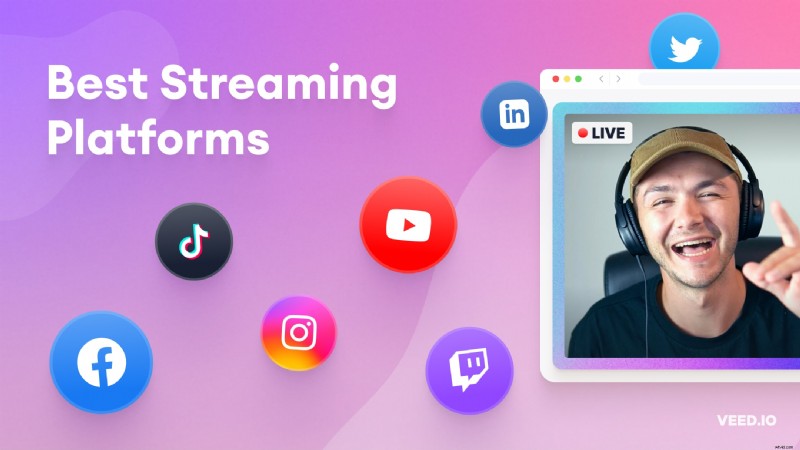
La plataforma en la que su público objetivo sea más activo y brinde funciones que respalden sus objetivos de contenido es la mejor. Por ejemplo, si planea hacerse un nombre en la comunidad de jugadores y monetizar los juegos, Twitch o YouTube serían la mejor opción. Realizar una sesión de preguntas y respuestas en vivo en Instagram en lugar de LinkedIn aumentará el compromiso de tu transmisión si eres un influencer de viajes.
Veamos las plataformas sociales populares de transmisión en vivo.
🎥 Contracción nerviosa
Se vieron 5650 millones de horas de video en Twitch en todo el mundo entre el 1 de abril y el 30 de junio de 2022, más del doble de la cantidad de tiempo que los usuarios pasaron en YouTube Gaming Live y Facebook Gaming combinados.
El sitio web se hizo famoso por las transmisiones en vivo de juegos, pero ahora es conocido por varias categorías. Just Chatting, por ejemplo, ocupó el lugar del tipo de contenido más visto en la plataforma, gracias a la pandemia. Cuando todos estaban enjaulados en el interior, se transmitieron en vivo en Twitch para interactuar con sus comunidades y matar el aburrimiento.
Los creadores también pueden monetizar sus transmisiones después de unirse al Programa de socios de Twitch.
🎥 YouTube
El gigante para compartir videos es la segunda plataforma de redes sociales más popular, con más de 2.500 millones de usuarios activos mensuales. La gran cantidad de creadores en YouTube hace que sea difícil destacar. Puede encontrar transmisores y canales en categorías de contenido que no sabía que existían.
Solicite acceso a la función de transmisión si va a transmitir en vivo en YouTube por primera vez. Pero la aprobación puede demorar hasta 24 horas. Una vez habilitado, puede comenzar a transmitir con solo hacer clic en un botón.
| ℹ️ Nota:su canal de YouTube necesita al menos 50 suscriptores si desea transmitir desde la aplicación móvil. |
Los creadores de contenido y las marcas se activan en Facebook para conectarse con una gran base de usuarios y hacer crecer su audiencia y su negocio. Puede transmitir en Facebook usando sus aplicaciones móviles o a través de una computadora.
Permite a los usuarios transmitir videos a sus seguidores, páginas, grupos o eventos. Y además de eso, Facebook Live ofrece potentes funciones para mantener a los espectadores interesados:encuestas en vivo, enlaces destacados y moderación de comentarios. Puede monetizar sus transmisiones en vivo utilizando la función Facebook Stars como creador.
LinkedIn se ha transformado de un simple portal de reclutamiento y redes a una plataforma de creación de contenido en los últimos años. Las personas usan el sitio web para construir sus marcas personales, hacer crecer negocios o encontrar ofertas de trabajo lucrativas. Las empresas publican contenido para atraer a los mejores talentos, aumentar las ganancias o crear una imagen positiva.
Puede transmitir videos en vivo en su perfil, la página de una empresa o un evento. Pero no todos pueden transmitir en vivo en el sitio web; tendrá que cumplir con sus criterios de elegibilidad para acceder a la función de transmisión en vivo.
| ℹ️ Nota:no puedes publicar en LinkedIn sin usar software de terceros. |
🎥TikTok
La popularidad de TikTok se ha disparado en los últimos años. Los videos cortos y atractivos de la aplicación mantienen a los usuarios desplazándose durante horas. Es común que los creadores de TikTok se vuelvan virales durante las primeras semanas de publicación en comparación con plataformas como YouTube o Twitch.
Debe tener 18 años o más para transmitir en vivo en la plataforma y monetizar sus transmisiones de TikTok. La aplicación también permite a los creadores agregar filtros y efectos en vivo. El transmisor puede filtrar comentarios, agregar moderadores e incluso recaudar dinero para obras de caridad utilizando las funciones integradas de la aplicación.
No hay restricción en el límite de tiempo de transmisión. Aún así, recomendamos no transmitir en vivo por más de 30 minutos, considerando que la audiencia de TikTok está acostumbrada a videos cortos.
🎥 Gorjeo
Twitter es famoso por sus mensajes de texto de formato corto llamados tweets. Los creadores como MrBeast y marcas como Netflix interactúan con frecuencia con sus seguidores en el sitio web. Puede tener transmisiones en vivo de solo audio llamadas Twitter Spaces y también publicar videoclips cortos.
Atiende a una categoría de nicho:noticias, entrevistas o una descripción general detrás de escena de un evento en curso. Puede transmitir en vivo en Twitter usando su aplicación de Android e iOS o una computadora de escritorio con la ayuda de software de terceros como OBS Studio o VEED.
La empresa propiedad de Meta comenzó como una aplicación para compartir fotos, pero ha agregado muchas funciones con el tiempo, al ver el éxito de plataformas como TikTok y Snapchat. Ahora está priorizando el contenido de video y reemplazando videos más largos con Reels. En resumen, los creadores y las marcas saben que los Reels son el ingrediente secreto para crecer en la aplicación.
Pero la transmisión en vivo en Instagram te permite destacar. Programe un Instagram Live con otro creador o marca en el mismo nicho o uno similar y aproveche la oportunidad de hacer crecer su cuenta.
¿Cómo?
Los seguidores de un usuario reciben una notificación, en algunos casos, en sus aplicaciones cada vez que la persona o la cuenta que están siguiendo se activa. Verte en la transmisión en vivo de cuentas familiares hace que los usuarios sientan curiosidad por revisar tu perfil. Es probable que hagan clic en el botón Seguir si has publicado contenido relevante.
¿Cómo aumenta tu audiencia la multitransmisión?
¿No sería genial transmitir en una plataforma en lugar de tres, aumentar tu audiencia y aumentar la participación de los espectadores? Y eso también sin poner el triple de esfuerzo.
¿Suena irreal?
La transmisión múltiple lo hace posible. Permite a los creadores transmitir video en vivo en múltiples plataformas simultáneamente, aumentando la audiencia.
Entonces, ¿cuál es el problema?
Aunque llegar a una audiencia amplia suena atractivo, tenga cuidado de elegir los canales adecuados. Comprenda la audiencia principal de cada plataforma y asegúrese de que sus intereses se alineen con el contenido de su transmisión.
Por ejemplo, como jugador, no multitransmita su juego en LinkedIn, un portal destinado al crecimiento profesional. En su lugar, opta por YouTube, Twitch y quizás Facebook.
Sin embargo, aprender a transmitir en vivo en diferentes canales simultáneamente puede ser un dolor de cabeza si no eres un experto en tecnología. No te preocupes, estamos aquí para ayudarte.
Las plataformas como VEED hacen que la transmisión múltiple sea simple y eficiente.
No es necesario aprender ni instalar ningún software complejo de transmisión en vivo. Transmita en vivo con VEED usando una computadora o una computadora portátil con solo hacer clic en un botón.
Explicaremos en detalle cómo puede realizar transmisiones múltiples con VEED, pero primero, hablemos de las herramientas que necesitará para configurar una transmisión en vivo.
[#TOC3]Equipo:¿Qué necesitas para empezar a transmitir?[#TOC3]
MrBeast comenzó con la vieja computadora portátil de su hermano y tiene más de 200 millones de seguidores (aumentando rápidamente) en sus canales de YouTube. La mejor ruta es comenzar simplemente. Pero MrBeast también actualizó su equipo tan pronto como comenzó a ganar dinero, sabiendo la importancia de tener las herramientas adecuadas para crear contenido de calidad.
Hablemos sobre la creación de una configuración de transmisión para principiantes.
Hardware de transmisión en vivo
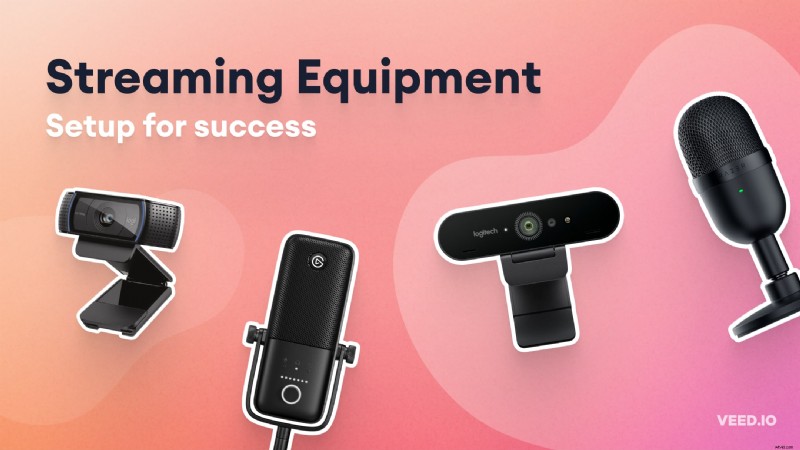
Dispositivo de transmisión
Necesitarás una computadora o un teléfono con al menos 10 Mbps de velocidad de Internet para transmitir video HD. La velocidad ideal requerida para la transmisión varía según la resolución del video y la cantidad de dispositivos conectados a la red Wi-Fi.
Sugerimos transmitir en vivo usando una computadora portátil o PC para tener más control.
Una computadora con alta potencia de procesamiento o una potente CPU ejecutará el software de transmisión sin problemas y procesará la entrada de video y audio desde la cámara web y el micrófono. Un Macbook, por ejemplo.
Para evitar fallas, recomendamos usar una computadora con:
- Intel i5 o un procesador igualmente potente
- SSD
- Al menos 8 GB de RAM
La mayoría de las PC o computadoras portátiles ahora tienen tarjetas gráficas integradas para transmisión en vivo básica. Aún así, necesitará una configuración más robusta y costosa para transmitir videojuegos con muchos gráficos. Algunos jugadores incluso usan una configuración de consola dual con una PC para jugar.
Cámara web
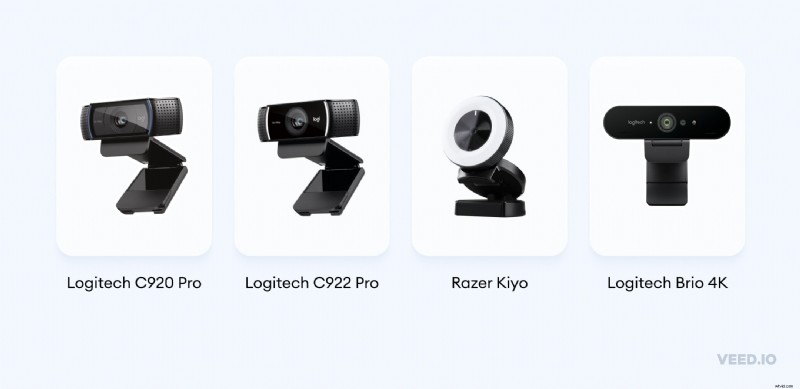
Puede usar la cámara integrada de su computadora portátil si tiene un presupuesto ajustado, pero invertir en una buena cámara web hará que su transmisión se vea más profesional. Y no tienes que gastar una fortuna en comprar uno.
Elija algo en función de sus requisitos:¿planea transmitir juegos o necesita que se publique en LinkedIn?
Compra una cámara web que tenga al menos estas funciones:
- 720p/60FPS; Resolución de 1080p/30FPS
- Aplicación de software del fabricante para ajustar la configuración de la cámara
- Función de enfoque automático
- Micrófono integrado
Estas son algunas cámaras de transmisión en vivo populares:
- Cámara web Logitech C920s Pro HD
- Cámara web Logitech C922 Pro HD Stream
- Razer Kiyo
- Cámara web Logitech Brio 4K
Elegimos estas cámaras web porque tienen excelentes críticas en línea y muchos expertos en transmisión las recomiendan. Razer Kiyo se destaca por su anillo de luz incorporado, mientras que Logitech Brio ocupa el segundo lugar debido a su capacidad de transmisión de 4k.
Sus precios oscilan entre $58,99 y $129 en Amazon EE. UU..
| ⚡️ Consejo:consulte otros sitios web para la venta. Encontramos una gran diferencia de precio en varias plataformas de comercio electrónico. |
También puedes usar la cámara de tu teléfono si tiene problemas financieros o rara vez muestra su rostro para videoconferencias o creación de contenido; Consulte este artículo de Wired sobre cómo convertir su teléfono inteligente en una cámara web.
Micrófono
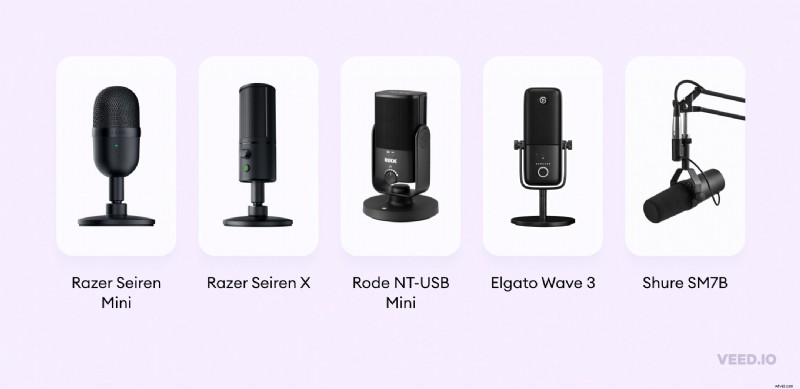
La calidad de audio de una transmisión en vivo es igual, si no más importante, que el video. Las personas escuchan podcasts o videos mientras hacen tareas, hacen ejercicio o se relajan. El audio deficiente da una mala impresión, afecta la participación del espectador y pierde la oportunidad de reutilizar la transmisión.
La audiencia de la transmisión debería poder escuchar a los oradores alto y claro, por lo que recomendamos no usar la cámara o el micrófono incorporado de los auriculares.
Compre un micrófono que elimine el ruido de fondo y proporcione un sonido equilibrado. La mayoría de los micrófonos vienen con dos tipos de conexión:XLR y USB. Los micrófonos XLR ofrecen audio de nivel profesional y requieren un mezclador o una interfaz de audio para conectar el micrófono a su PC.
Pero hay una trampa. Las cámaras XLR son mejores pero caras. Opta por micrófonos USB, ya que son geniales para los novatos.
Estos son algunos de los mejores micrófonos de transmisión para principiantes según expertos en transmisión, creadores de contenido y reseñas en línea:
- Razer Seiren Mini
- Razer Seiren X
- Rode NT-USB Mini
- Elgato Ola 3
El precio de estos micrófonos comienza desde $ 44 en Amazon EE. UU. Agregue un filtro pop a su configuración de audio para mejorar aún más la calidad.
| ℹ️ Nota:Compre Shure SM7B si tiene un gran presupuesto. Es una opción popular recomendada por muchas publicaciones tecnológicas, transmisores y creadores de videos. |
Luz natural o luz anular
La mala iluminación puede hacer que un video parezca amateur y poco profesional. La mejor cámara de transmisión no ayudará si está transmitiendo desde una habitación con poca luz.
Sin embargo, no es necesario que compre equipos de iluminación costosos como transmisor principiante. La luz natural suele ser una buena opción y da un aspecto cálido. Y si usar la luz del sol no es una opción, puede optar por una luz de anillo.
Además, use una combinación de anillo de luz, luz natural y luces de techo instaladas en su espacio de trabajo o estudio. Obtenga una vista previa de la iluminación en la cámara antes de transmitir en vivo y ajústela para obtener la mejor calidad de video.
Agradable de tener (pero no necesario para principiantes)
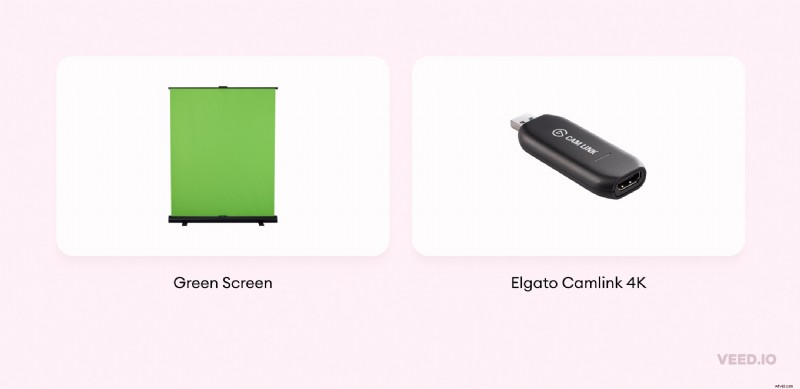
Si bien la configuración mencionada anteriormente es lo suficientemente buena para la mayoría de los streamers principiantes, puede mejorar constantemente la calidad. Actualice su configuración de transmisión si tiene el presupuesto y los requisitos.
Pantalla verde
¿Quieres agregar un fondo personalizado o de video a tu transmisión?
¿O tal vez quieres retratar que estás sentado en una oficina?
Una pantalla verde podría ayudar. Utiliza la tecnología chroma key para transformar un fondo verde en un escenario virtual. Agregue marcas, CTA o efectos visuales que podrían mejorar la calidad del vapor. Compra una pantalla de nailon o muselina que cubra el campo de visión de tu cámara y tenga el más mínimo reflejo.
| ⚡️ Consejo:para evitar fallas en la pantalla verde, no use un atuendo verde y coloque la pantalla a distancia para evitar proyectar sombras. |
Capturar tarjeta
Una tarjeta de captura es un dispositivo que transmite imágenes sin procesar de una cámara o una fuente de video (como Xbox o PlayStation) en un formato que su computadora puede reconocer y transmitir.
La tarjeta generalmente se conecta a través del puerto HDMI de la fuente mediante un cable HDMI. You can’t directly transfer video from the camera by connecting it to a computer’s HDMI port. ¿Por qué? Because those are HDMI output ports, they can transmit video signals, not receive them.
The card "captures" what the camera or the video source is recording and then converts and transfers the video signal to your computer.
Elgato Camlink 4K is a popular choice among video creators and has excellent reviews.
| ℹ️ Note:You don't need a capture card while using a USB camera or a webcam. |
DSLR Camera
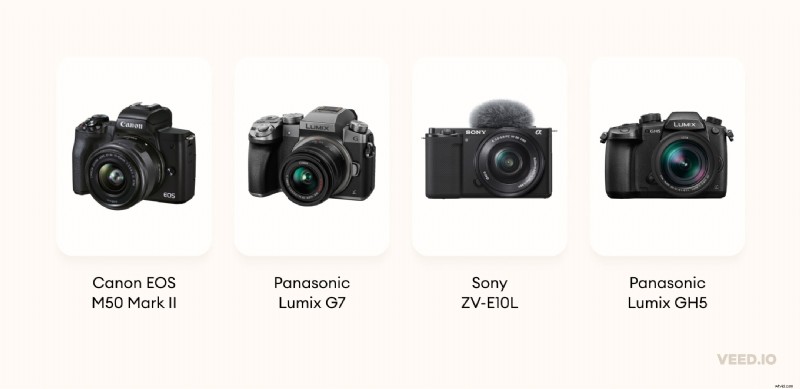
Webcams like Logitech Brio 4K (mentioned earlier) provides superior picture quality, so what’s the need for a DSLR for streaming?
Professional cameras have higher resolution and advanced camera settings, making video quality superior to webcams. You can upgrade a DSLR by adding better lenses and attachments – not a webcam.
However, such cameras are expensive, have a complex learning curve, and need attachments like a capture card to transmit video to a computer. They also need more processing power and might slow down your computer.
Without going into further technicalities, here are some popular DSLR cameras for streaming:
- Canon EOS M50 Mark II
- Panasonic Lumix G7
- Sony ZV-E10L
- Panasonic Lumix GH5
Lighting kit
You can upgrade your video lighting setup if a ring light, natural light, or a room’s lighting isn’t enough. Three-point lighting is popular among streamers because it’s best for one person's setup and combines key light, fill light, and backlight.
You can also use a black background so that it doesn't reflect any light from other sources like incandescent lights or fluorescent bulbs.
Live Streaming Software
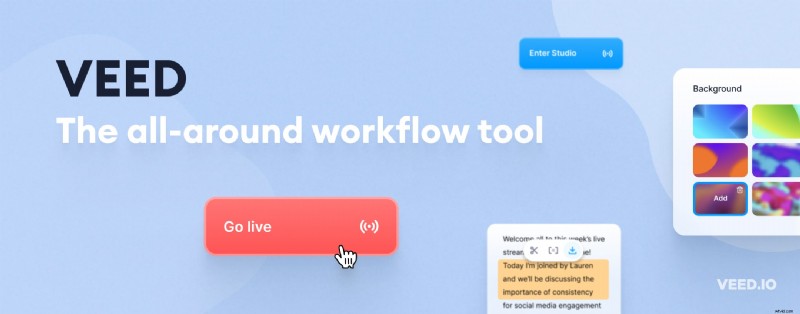
Plug a webcam and a microphone, and go live via a web browser with a click of a button. Sounds simple, doesn’t it?
This is how you can live stream using a free streaming software like VEED .
Here is a list of some other streaming tools:
- OBS Studio
- Streamyard
- Restream
OBS Studio is well-known in the streaming community, offers vast customization options, and allows connecting multiple audio and video sources. But it’s complex to learn, and you’ll have to spend hours on OBS tutorials if you aren’t tech-savvy.
On the other hand, VEED is highly intuitive and allows multistreaming straight from your browser with a few clicks. Use it to easily invite stream participants without integrating it with tools like Zoom or Discord, which OBS requires. Imagine inviting multiple guests for a podcast with only one link. No signups, no hassle -- that is VEED.
It also empowers creators and brands to customize the stream’s design and select different video layouts for consistent branding.
We will talk more about VEED later, but first, let’s discuss live stream ideas for some inspiration.
[#TOC4]10 Live Streaming Content Ideas[#TOC4]
1. Educational How-To Videos
You can educate your audience by sharing your expertise and answering their questions simultaneously. For example, popular course creator and podcaster Pat Flynn discusses a step-by-step process to create a profitable online course.
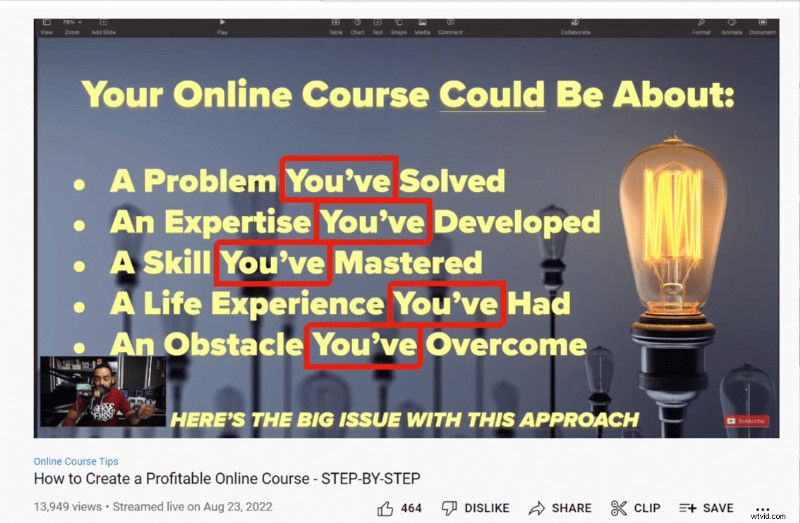
2. Share Your Industry Experience
Share your industry experience and help beginners in the same field.
For instance, VEED’s team of experienced creators did a live stream about what to watch out for when starting as a video content creator. They talk about things like not focusing too much on buying expensive gear and just starting.

3. Launch Event
Use a live broadcast to launch and explain a product. Take Ambreen Nadeem's case as an example. She reveals her first book on LinkedIn Live.
Nadeem also adds viewers to the stream, shares how she came up with the idea and talks about the book structure.
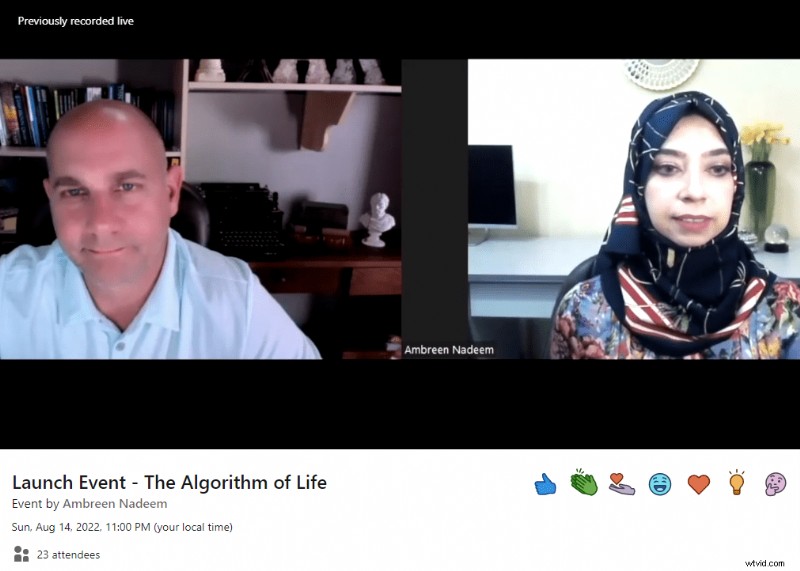
4. Tutorials
Creators can leverage streaming to teach their audience how to do something and connect with their fans simultaneously.
See how the YouTube channel “Dad, how do I?” used the opportunity. Robert Kenney started on YouTube to show kids without dads or bad childhood basic stuff a father would teach them. For example, how to shave or change a tire.
The below screenshot of a live broadcast shows him and his daughter teaching viewers how to carve a pumpkin. The heartwarming comments for the “Internet Dad” will make you smile.

5. Collaborate With An Industry Expert
Invite experts to join you for a live session and discuss things that would benefit your audience. You can collate questions for the expert before the stream or ask viewers to post them in the comment box.
Case in point, see Charlene Brown’s stream on how automation can benefit entrepreneurs. The LinkedIn Live was engaging and had 121 comments.
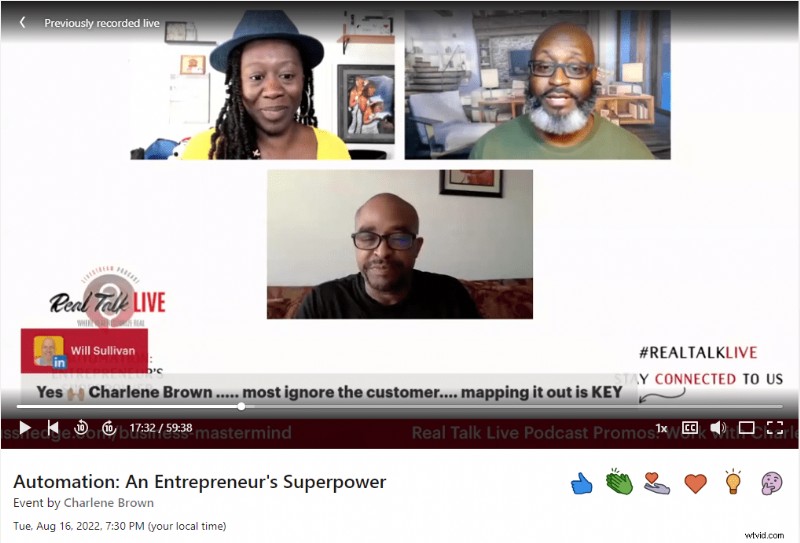
6. Host a Q&A Session
Have a dedicated questions and answers stream. Use the broadcast to show your expertise and care for your viewers. Doing this would help you build a stronger community and upsell after earning people’s trust and establishing yourself as an expert.
“Live Streaming Pros,” as you can guess by the name, is a YouTube channel dedicated to streaming. The channel frequently does live broadcasts to connect with its viewers.
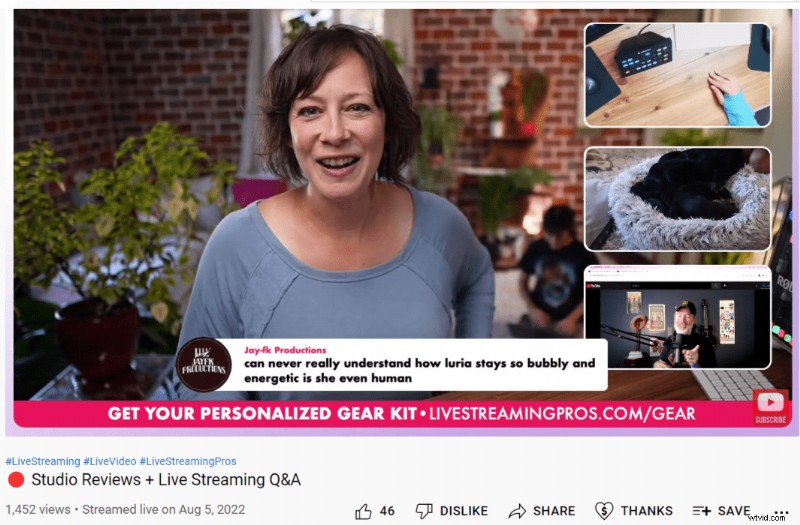
7. Video Games
Gamers can broadcast their gameplays on YouTube, Facebook, and Twitch, and they can also add commentary, do giveaways and monetize their streams.
Customize your stream by adding backgrounds and overlays and create your signature style to stand out. Because the gaming niche is so competitive, we recommend you multistream on different platforms to reach a wider audience.
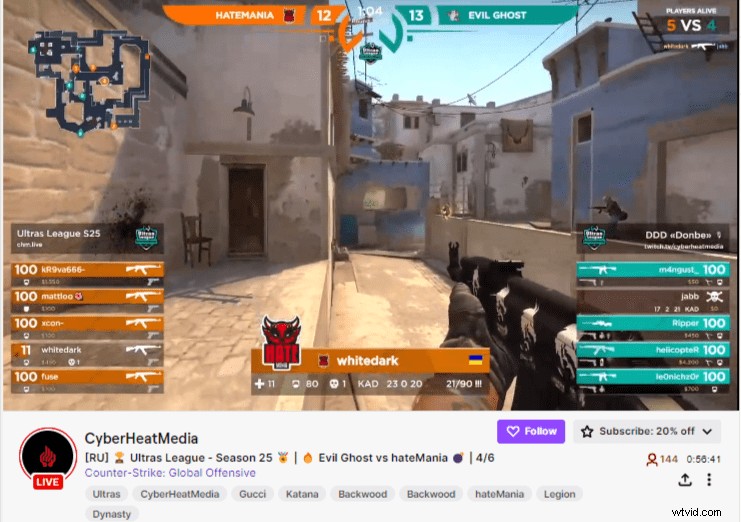
8. Live Critique or Evaluation
You can also use a live broadcast critique work specific to your niche. Evaluate business plans, review code, or show how a graphic could have been better.
Take the YouTube channel The Content Studio as an example. Tommy Walker, an experienced marketer, calls senior writers and editors on the show to share their expertise and edit a draft during a stream.
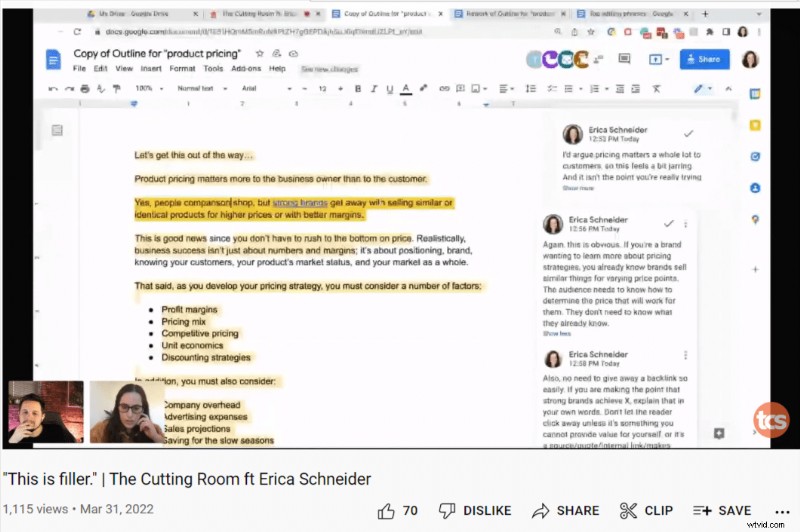
9. Product Unboxing Or Tech Reviews
Suppose you run a channel focused on the latest in tech and gadgets. In that case, you can leverage streaming to do product unboxing or review recently launched phones. Going live allows you to address questions in real-time and increase viewer engagement.
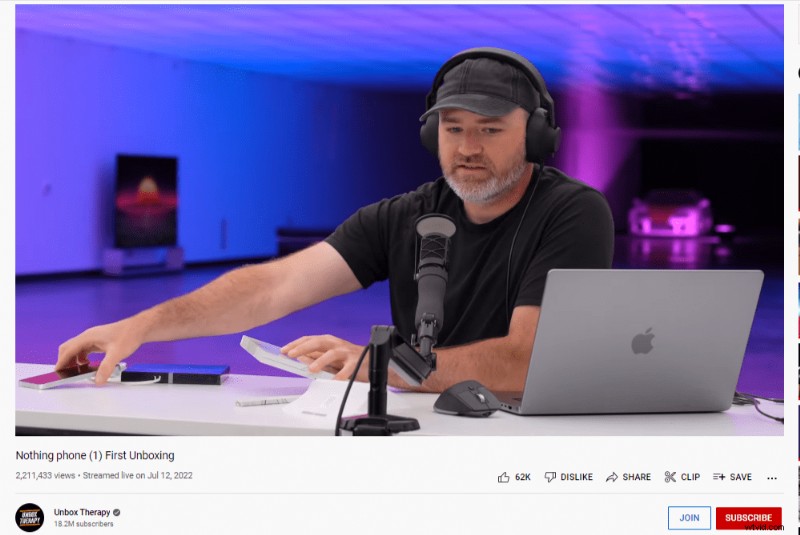
10. Reaction videos
Broadcast a live video reacting to your viewers’ work and suggest how they can do a better job. Omar from Think Media, for example, breaks down and reviews videos shared by others. He also shares pro tips and gives relevant examples.

[#TOC5]How To Live Stream With VEED[#TOC5]
Here is a ten-step process on how to live stream:
- Connect your video and audio devices
- Open www.veed.io in your browser and create a VEED account if you don’t have one
- Click the Go Live button
- Set a display name and adjust your camera and audio settings
- Customize the design of your stream
- Click on Setup broadcast to connect to your preferred platform(s)
- Click on Go Live Now to start streaming using VEED
- Share screen
- View and highlight the comments from different channels
- End the stream and go to the dashboard
Keep reading for a detailed explanation of each step.
1. Connect your video and audio devices
Cameras, microphone, headset, or ring light – connect every device before you start the broadcast.
2. Open www.veed.io in your browser and create a VEED account if you don’t have one
If you have to make a new account, follow the prompts during the signup process until you see an option to choose a VEED plan. Make a choice based on your requirements; see the screen below. Click on the Continue to Workspace link on the top right.
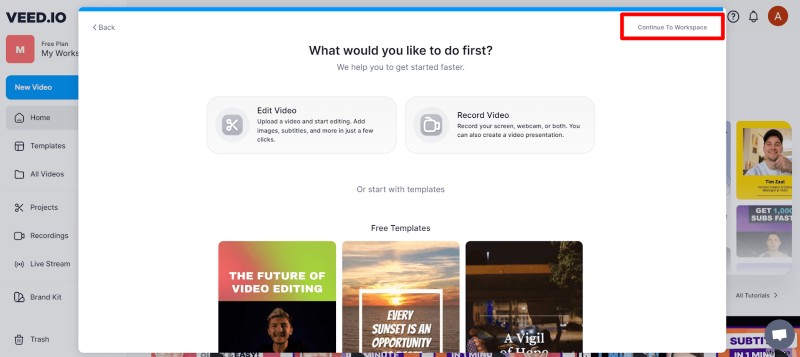
VEED will open your private workspace that looks like the image below.
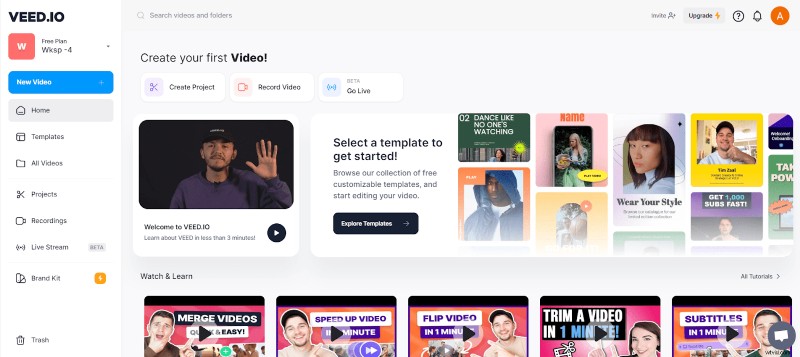
Log in to VEED if you’re an existing user. Whether you sign up for a new account or log in to an existing one, you should be able to see the Home screen of your editing workspace.
For this blog, we are primarily using a free account.
3. Click the Go Live button
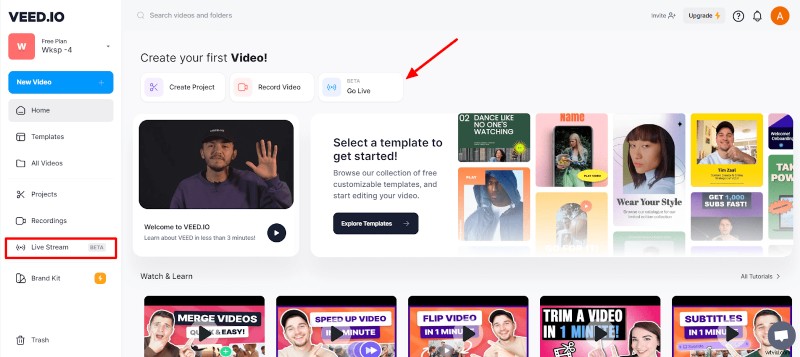
You can also start a live stream by clicking on the Live Stream section on the left panel. Please grant your camera and microphone access if you’re using VEED for the first time.
4. Set a display name and adjust your camera and audio settings
You’ll be able to see the below screen after you click Go Live.
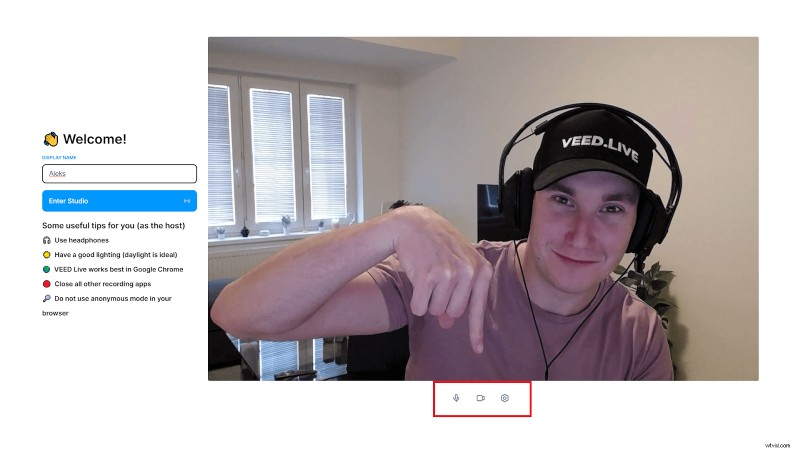
Choose the microphone, camera, and audio output by clicking on the settings icon at the bottom.
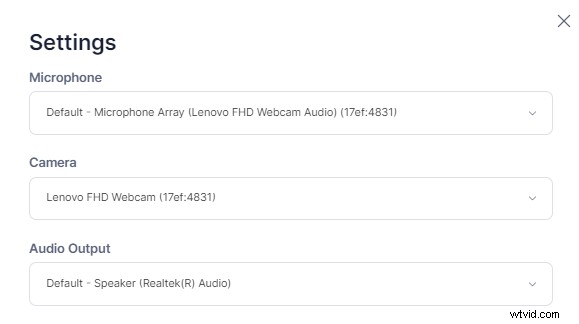
Add the display name, click Enter Studio, and you’ll see the screen below.
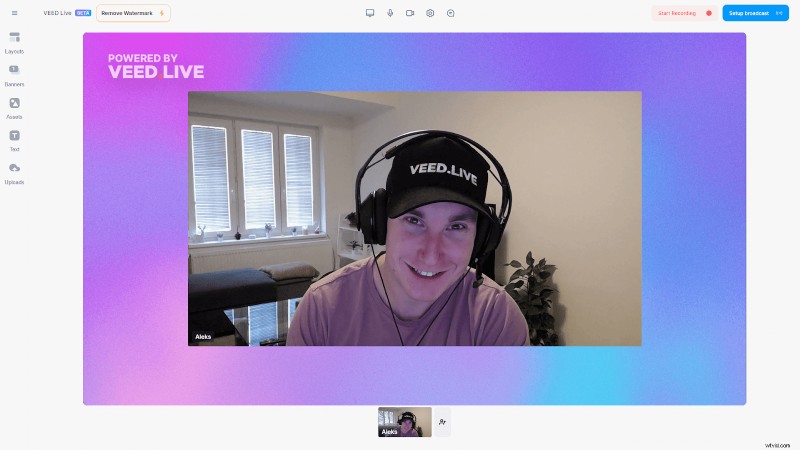
Live stream viewers will see a VEED watermark if you're using a free plan. You can delete this by clicking on the Remove Watermark button to upgrade your plan.

5. Customize the design of your stream.
VEED allows you to customize your stream with various fonts and backgrounds. It also enables creators to add elements like stickers, pop-ups, and logos.
Click on the elements you want to customize on the left-side panel.
In the below image, for example, we have added Twitter and YouTube logos along with VEED’s social handles on these platforms. We have also included the “On Air” sticker and the heading about the topic of the stream.
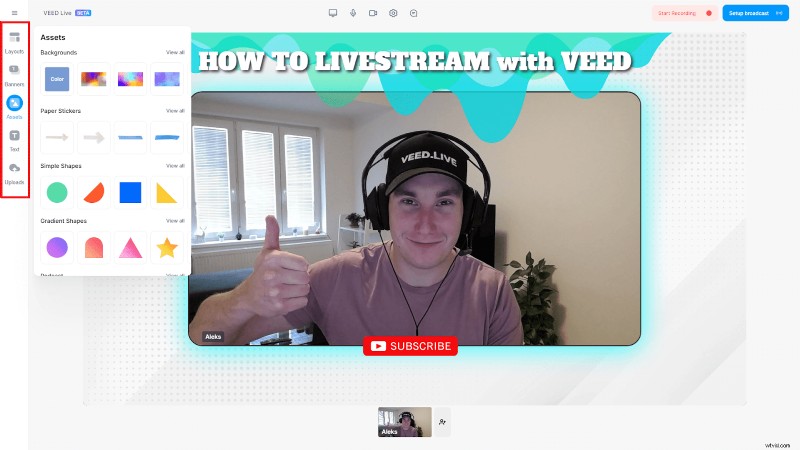
The online platform also offers the functionality to add custom images and backgrounds. And can also allow you to change the stream layout using the options within the Layouts button.
As shown in the image below, the layout options for screen share are disabled, and you’ll be able to use them once you start the screen share.
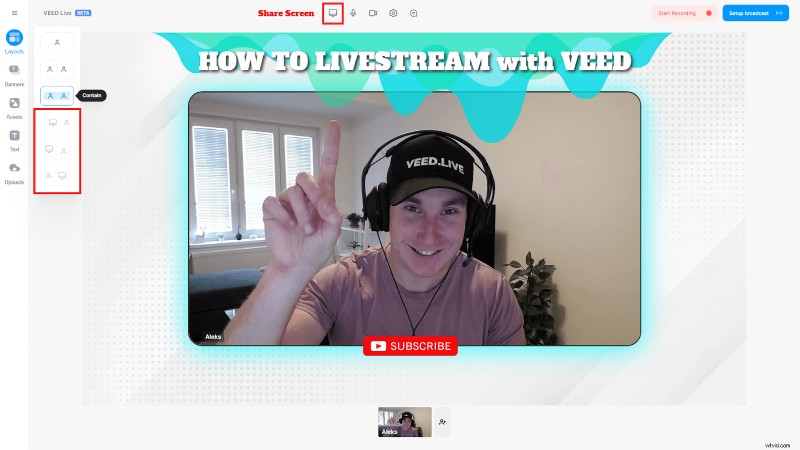
We will talk more about the screen share feature later.
| ℹ️ Note:You can customize your stream’s design while you’re live, but it’s a good practice to set up a basic layout beforehand. |
Now let’s talk about integrating VEED with popular live streaming platforms.
6. Click on Setup broadcast to connect to your preferred platform(s).
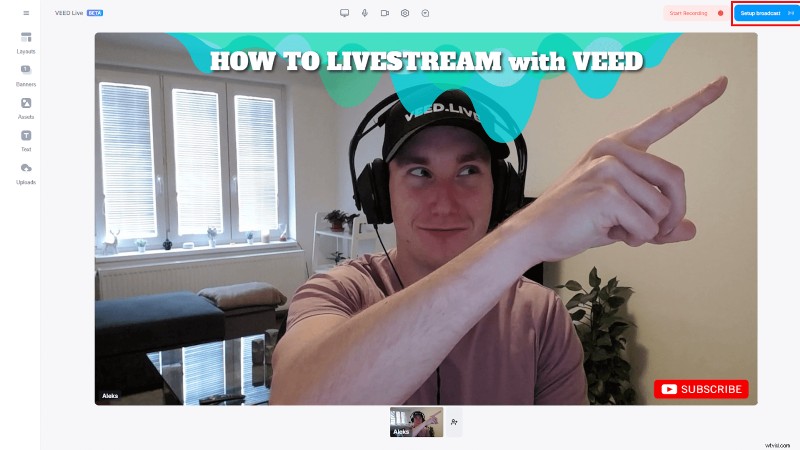
You’ll be able to see the Stream settings pop-up.
VEED saves you the hassle of opening multiple tabs if you want to go live on various platforms.
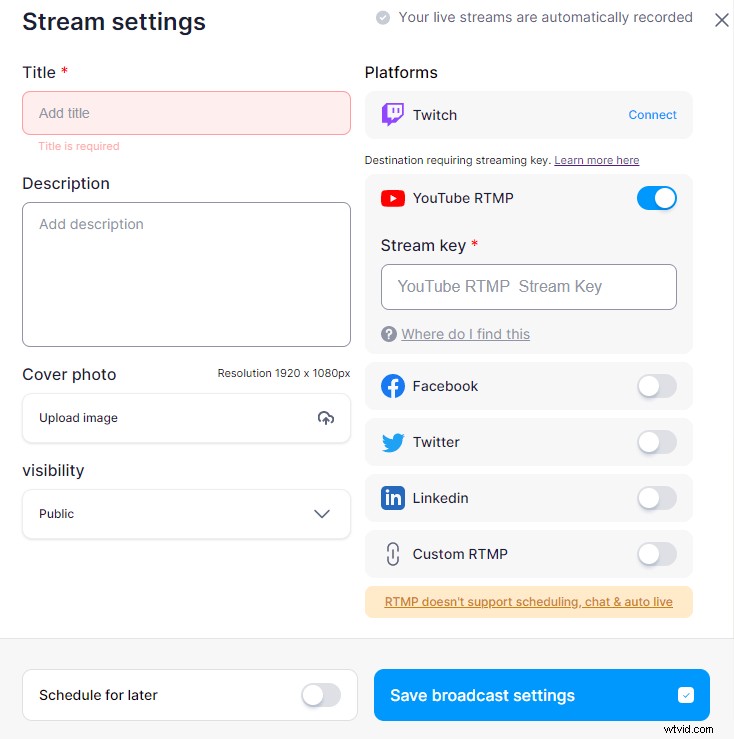
Select the platform(s) you want to stream on and add their respective keys. Add the title, description, and cover image.
Read this guide on how to find your stream key for Twitch, YouTube, Facebook, Twitter, and LinkedIn
| ℹ️ Note:People with access to your stream keys can go live via your social media handles without knowing their respective login credentials. Keep your keys private. |
Suppose you’ve to stream on Twitch and YouTube simultaneously.
After you enter the required details and save the broadcast setting, you will see the logos of the platforms you enabled for streaming in the top-right corner. Having such logos displayed helps you avoid accidentally going live on other channels that you might have connected with VEED for another stream.
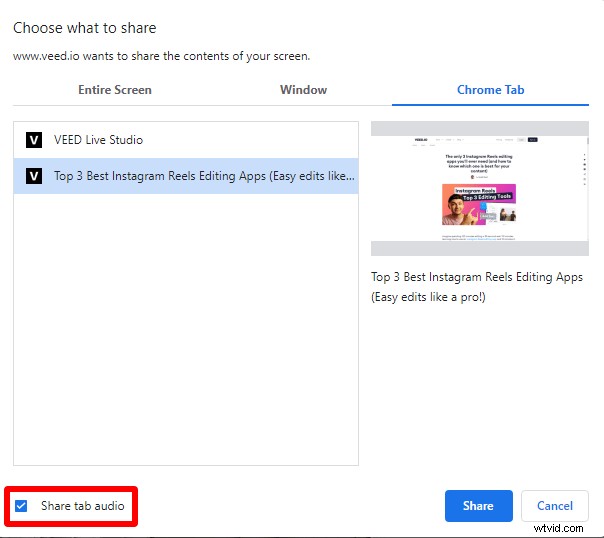
VEED also allows you to add custom RTMP. We don’t want to bore you by getting into the technicalities of RTMP and how it works. In short, you can use the custom feature to live stream on platforms like Vimeo and Microsoft Teams.
Set the stream's visibility as Public, Private, or Unlisted if you’re going live on YouTube. You can also schedule the stream from the broadcast screen.
If you’re a growing creator, we recommend you set the visibility as public so you can reach a wider audience.
7. Click on Go Live Now to start streaming using VEED
The End stream button will replace the Go Live Now button once the stream starts.

VEED automatically starts recording the broadcast the moment you go live.
8. Share screen
As promised earlier, let’s talk about the screen-sharing functionality.
Click on the Screen Share button at the top, and you will see the below pop-up. You can share your entire screen, a window, or a web browser tab. Select the checkbox at the bottom if you want to share the system or tab’s audio.

Click the blue Share button and see the following screen.
Notice that screen-sharing layout options (annotated on the left) that were disabled earlier are now enabled.

Invite others to join the stream by clicking the button at the bottom.

The invitees can join your stream with a click of a button and are allowed to message you in the private chat box.
9. View and highlight the comments from different channels
VEED allows the streamer to see comments from all the channels where the live video is broadcasting in one place:the Public chat caja. You can identify a comment’s source based on the platform’s icon attached to it.
Highlight a viewer’s comment by clicking Show on stream . Such small gestures make people feel special. Use banners from the left-side panel to highlight important information or add a CTA.
10. End the stream and go to the dashboard
Click End stream to finish the broadcast and go to the streaming dashboard. Open the recorded stream after it’s rendered.
VEED automatically transcripts the stream’s recording. You can download it as a text or SRT file by clicking on the bottom-right buttons.
Edit the video simply by deleting the text of the transcript to repurpose it for other platforms. It gets even better. You can easily highlight a piece of text and open it in the VEED editor to turn it into a shorter clip for your socials.
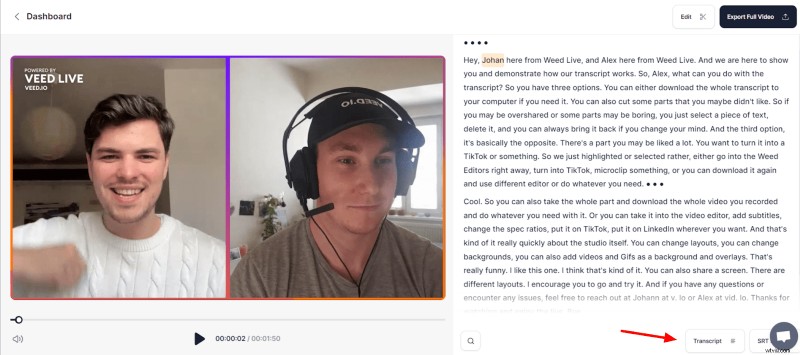
[#TOC6]6 Live streaming best practices[#TOC6]
1. Plan And Prepare Well
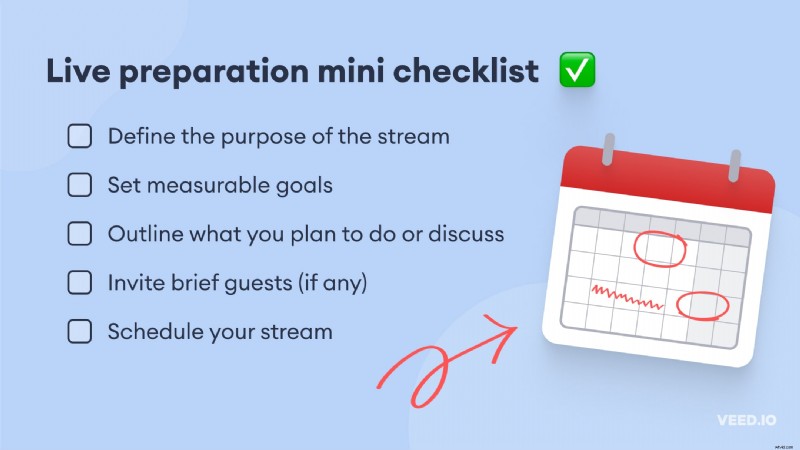
Define the theme and purpose of the stream. Do you want to give a product demo and resolve queries in real time? Or do you aspire to build a more engaged community?
Having a goal will make every aspect of your live streaming strategy manageable. For example, suppose your objective is growing your Instagram followers. In that case, go live with other creators in your niche. Making such strategic decisions increases the probability of attracting relevant followers.
Prepare a rough structure and schedule the stream when your audience is most active on your chosen platform.
Take Tommy Walker from The Content Studio as an example. He gets on a call with his guest a day or two in advance to "figure out the vibe" and loosely discuss the stream's structure. Walker also shares previous episodes that the guest will find relevant.
2. Promote Your Stream
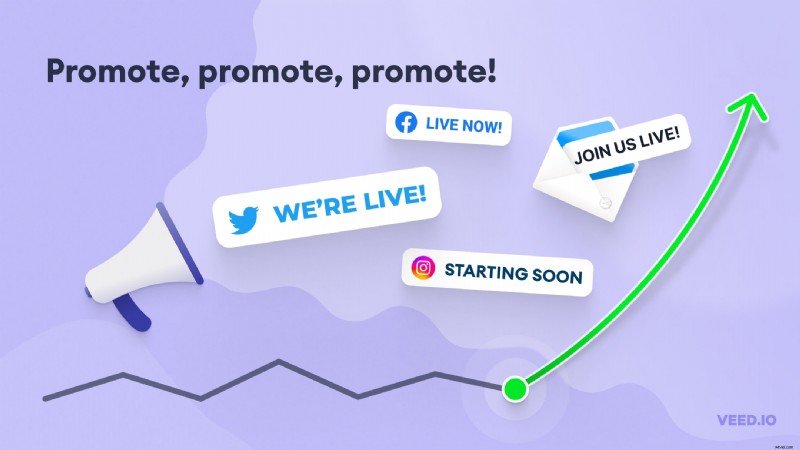
There is no point in going live if you and the stream moderator are the only people who join. Create promotional content and include all the relevant details (date, time, topic) so viewers know what to expect. Then distribute it across social media, email, and forums.
You can also ask your creator friends or employees to promote the stream on their social handles. Remember:the number of people joining your stream is proportional to the excitement you create about it.
3. Test Before Going Live
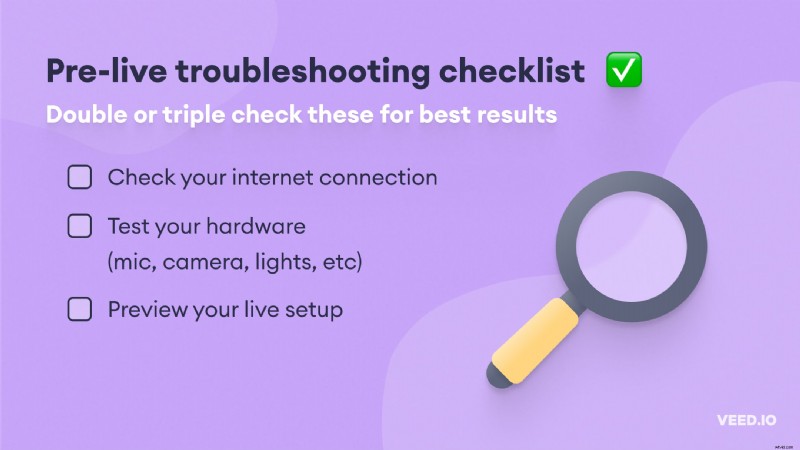
Check your streaming setup before you go live. Start with the internet speed and then move to the hardware:camera, mic, headphones, and lighting equipment. Ensure the streaming software doesn’t show any glitches.
Preview the background and adjust the lighting for the best quality. We also recommend testing special effects like virtual backgrounds and GIFs you may want to use during the broadcasts. It's even better to review everything more than once to avoid surprises during the broadcast.
4. Use Graphics Or Lower Thirds

Customizing and branding your stream using graphics and lower thirds makes the broadcast look more engaging and professional. Add a logo, social media handles, or the call-to-action (CTA) to the broadcast screen. Moreover, you can also include custom banners, backgrounds, and overlays.
We recommend setting up graphics before you start the broadcast. Adding lower thirds or the logo while streaming shows the audience that you are unprepared. Additionally, you’ll have to use third-party streaming software for adding graphics, as most platforms don’t have customization features.
5. Interact With Your Audience Often To Keep Them Engaged
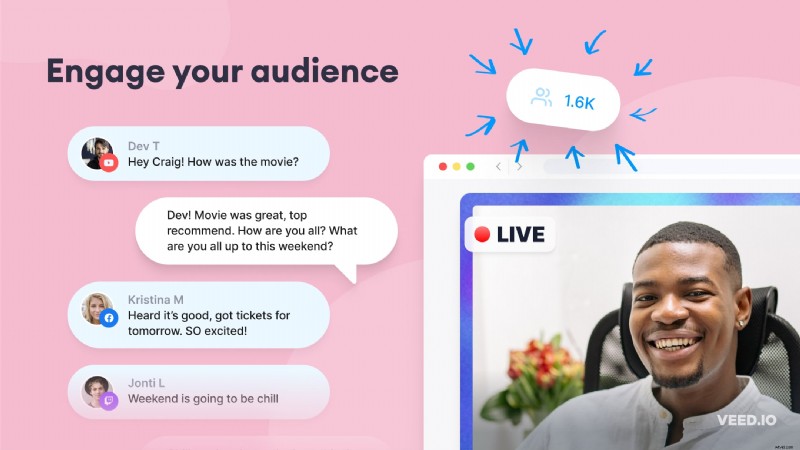
The opportunity for real-time interaction in a live broadcast makes it stand out from comments on a recorded video. Use streaming to make your viewers’ experience more enjoyable. Encourage them to post questions and comments in the chat and respond to as many as possible.
Add viewers to the stream, and hold live polls and quizzes. Even a simple gesture like giving a shoutout or highlighting a comment can make someone’s day.
LinkedIn Live streaming expert Gabe Leal says, "many will resonate with you when you regularly do live video streams. Be mindful that these people want to learn more about you, your knowledge, experience, and story." Leal adds, "connect with them and respond to messages and comments. Share the idea of creating community amongst your audience."
| ⚡️ Tip:Don’t panic if something goes wrong, like glitches with audio or video. People understand it’s a broadcast, and everything can’t be perfect. Being authentic makes you more relatable. |
6. Resize And Repurpose Clips From Your Live Stream For Social Media
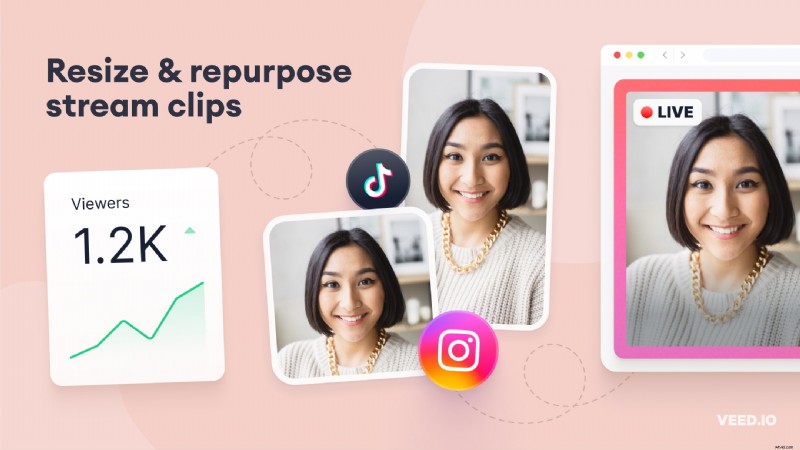
Not everyone has the time to watch lengthy videos. Ending a live stream doesn't mean your work is over. Long-form video content is a content factory. For instance, you can repurpose an hour-long podcast video into many social media assets for different platforms.
¿Cómo?
Take exciting clips from the video and turn them into Instagram Reels or post them on TikTok. YouTubers like Joe Rogan and Dude Perfect repurpose their videos to YouTube Shorts; why shouldn't you? People are likelier to watch a 15-second clip than listen to a new podcast.
Grab this opportunity to grab people's attention and then ask them to check your website or the longer video. You can use VEED to conduct, record a live stream, and resize the video for different channels.
Final Thoughts
With the popularity of streaming growing, more people and brands will be taking advantage of live broadcasting to spread their message and connect with an audience. Additionally, it is an excellent opportunity to gain loyal customers. However, more popularity means more competition.
You can stand out if you’ve got the right tools for faster and better execution:more live streams, on-brand customization, content repurposing, and much more. But we understand doing so many things can be overwhelming.
Fortunately, there is a simple solution, and it’s called VEED.
We showed you how to live stream with VEED, but it is much more than streaming software. While tools like OBS Studio have advanced streaming capabilities, it has a complex learning curve. Moreover, you’ll have to pay for video editing software if you want to repurpose your broadcast.
On the other hand, you can use VEED to record, edit, and resize the live stream for distribution on various social media platforms. Its intuitive interface, powerful features like subtitle translation, and video and audio conversion make it practically a steal.
Looking to create professional-level streams even when it’s your first time?
Try live streaming with VEED.
